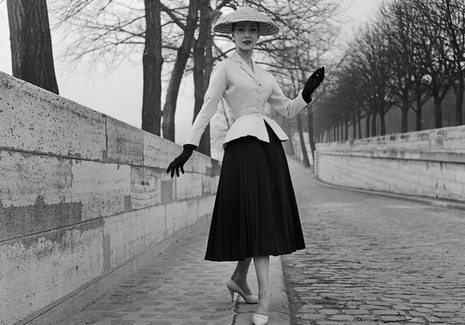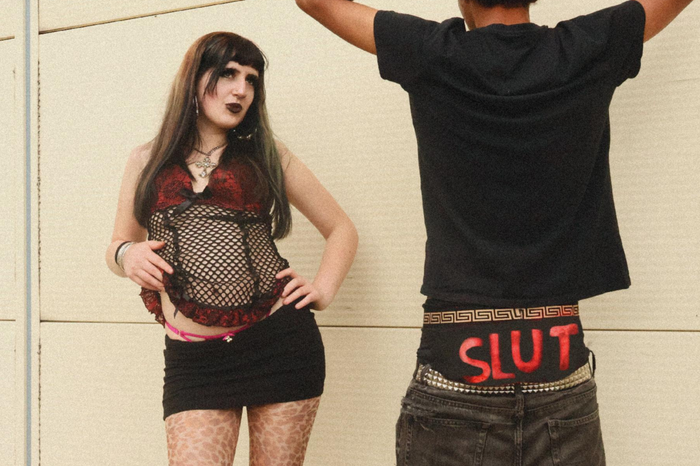Lipstick, lingerie, and liberation: Sabrina Carpenter’s housewife rebrand
Irina Echim analyses the sexual politics of Carpenter’s recent image shift

The world came to a screeching halt when two weeks ago, a pop star famous for mimicking sex positions during concerts dared to share with the world her next album’s cover, which features her on her knees in front of a man, who tightly grips her disheveled hair. Some have called the image degrading and unfeminist, while others see it as empowering. A new TikTok trend emerged, featuring melodramatic songs and comparisons between Carpenter’s album cover, Sydney Sweeney’s new soap ad and photos taken at women’s rights marches. The purpose seems to be to underline the degradation of the 21st century’s feminist movement, or, at least, to foreground tensions between contemporary modes of female empowerment. But, as Louis Staples notes in his Harper’s Bazaar piece on the subject, both sides lack nuance in this debate. Perhaps one of the most important details, disregarded by most of the internet, is that the ‘ideology’ of Carpenter’s cover was foreshadowed by her former stylistical choices.
“Tights, lingerie and corsets gesture towards the era of postwar American fashion”
Ever since her rebrand, it has become increasingly hard to associate Carpenter with anything less than glamorous blow-outs, sparkling corsets, thigh-high, lacy tights and vintage lingerie. In her 2024-2025 tour, these represented most of the artist’s concert outfit choices. Carpenter’s style is imbued with nostalgia, a marketing strategy that exploits the contemporary predilection for cultural melancholia. Tights, lingerie and corsets gesture towards the era of postwar American fashion, referencing the type of garments women wore in their homes. It recreates – in the bold colours of a society that has traversed the sexual revolution – the style of the housewife.
Nostalgia can be lovely. It may come to prompt social change or, at the very least, a reflection on the idiosyncrasies of the present. But there is no getting around the fact that nostalgia, for women, is perilous. Frankly, there are not sufficient eras in which women enjoyed enough rights to allow for an ethical romanticisation of the past. The era Carpenter has chosen for her pop identity is notorious for its inimicality to feminism. It might, however, be the best period to think through the issues of her latest album cover.
In ‘The Feminine Mystique’, Friedan articulates the ambivalence of the condition of the housewife. From the outside, it looked like the ideal fate chosen by a woman who willingly rejected the role of working woman in favour of the jubilant stay-at-home wife. In her recent Rolling Stone shoot, Carpenter wears a bra, panties and a plaid dressing gown. She is in the woods, right next to a deer. Yes, a deer. This photo persona is disturbingly similar to the contemporary trad wife, the 2020s equivalent of the postwar suburban housewife. In her recent stylistic choices, Sabrina has consistently positioned the image of the stay-at-home wife at the forefront of her artistic identity.
Her 2025 Met Gala and Dior June fashion show looks may be interpreted as a refutation of my previous claim. After all, the woman is wearing suit-like garments, referencing the image of the ‘working woman’. In the case of the Dior outfit, what Sabrina is referencing is the postwar New Look, which actually aimed to re-feminise women’s clothing and has long been deemed as regressive for the feminist movement. Somewhat similarly, Sabrina feminises her Met Gala suit by pairing it with micro-shorts and a cleavage-exposing corset.
“The corsets’ appeal for the male gaze is counteracted by their sparkle and coquetry”
This said, claims that Carpenter’s style or her album cover are sexist might be oversimplifications of the discursive machinations at play. After all, Carpenter is a singer and her lyrics are anything but housewifey. She sings about love and sexuality, not marriage and motherhood. Contemporary feminist rhetoric has deemed the former two to be liberating, while the latter two are seen as patriarchal institutions. By revamping the garments of patriarchy with sexually-liberated lyrics, Carpenter contests the era she is referencing through her clothes. The corsets’ appeal for the male gaze is counteracted by their sparkle and coquetry, which mainly pleases the female gaze. Similarly, the sexiness of her Rolling Stone garments is joined at the hip with the material’s playfulness. Carpenter gains great pleasure from mocking patriarchy through the things she wears. In the famous scene from the music video of ‘Feather’, when she kills a guy who sexually harassed her by trapping him in an elevator, she wears a belt around her neck as a choker. Taken out of context, the accessory is as harrowing as her latest album cover. Contextualisation unveils the conceit behind Carpenter’s artistic vision and branding strategy: the satirising exploitation of male lasciviousness.
The playfulness of Carpenter’s style fails, however, to make an appearance in the album cover, where she wears a short, but otherwise orthodox, black dress. The renunciation of her housewife persona might represent a response to the photo’s gender tensions. Her femme fatale persona opposes interpretations of her as servile or submissive. Fashion works toward empowering a woman whose spatial position negates empowerment. This said, somewhere in the picture art (fashion) fails to bring about ideological liberation from sexual domination. Similarly, many of Carpenter’s fans have revised their opinion regarding the feminist potential of Carpenter’s sexual lyrics.
The word ‘empowerment’ belongs to the diction of choice feminism. The empowerment perceived in Carpenter’s album cover comes from the fact that the audience believes Carpenter, with all her agency (both economic and artistic), has a choice. A choice in her branding. A choice in her style. A choice in her appearance. While I do not contest this, I do want to highlight that 1950s housewives – those fascinating creatures Carpenter takes pleasure in reminiscing about – also believed they had a choice. In the privileged, artistic world, an image of a woman on her knees is fun, practical, rage-baity. In the real world, where OnlyFans and sexual human trafficking coexist, such an image is ambivalent. In a world where both sexy pop lyrics and rape exist, one should never place too much confidence in female sexuality’s ability to contest the bondage of male sexuality.
 Comment / Plastic pubs: the problem with Cambridge alehouses 5 January 2026
Comment / Plastic pubs: the problem with Cambridge alehouses 5 January 2026 News / Cambridge academics stand out in King’s 2026 Honours List2 January 2026
News / Cambridge academics stand out in King’s 2026 Honours List2 January 2026 News / Cambridge businesses concerned infrastructure delays will hurt growth5 January 2026
News / Cambridge businesses concerned infrastructure delays will hurt growth5 January 2026 News / AstraZeneca sues for £32 million over faulty construction at Cambridge Campus31 December 2025
News / AstraZeneca sues for £32 million over faulty construction at Cambridge Campus31 December 2025 Interviews / You don’t need to peak at Cambridge, says Robin Harding31 December 2025
Interviews / You don’t need to peak at Cambridge, says Robin Harding31 December 2025










